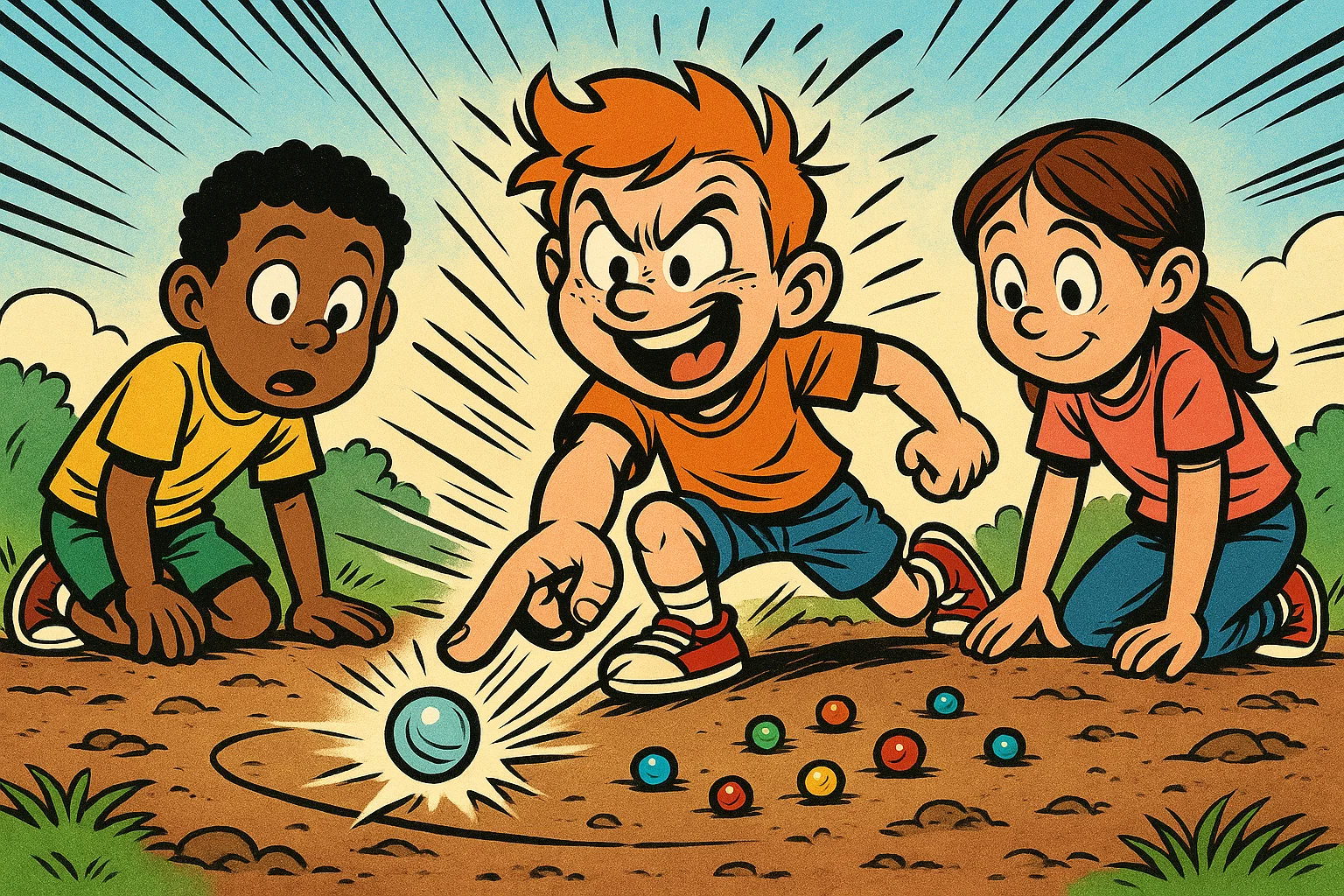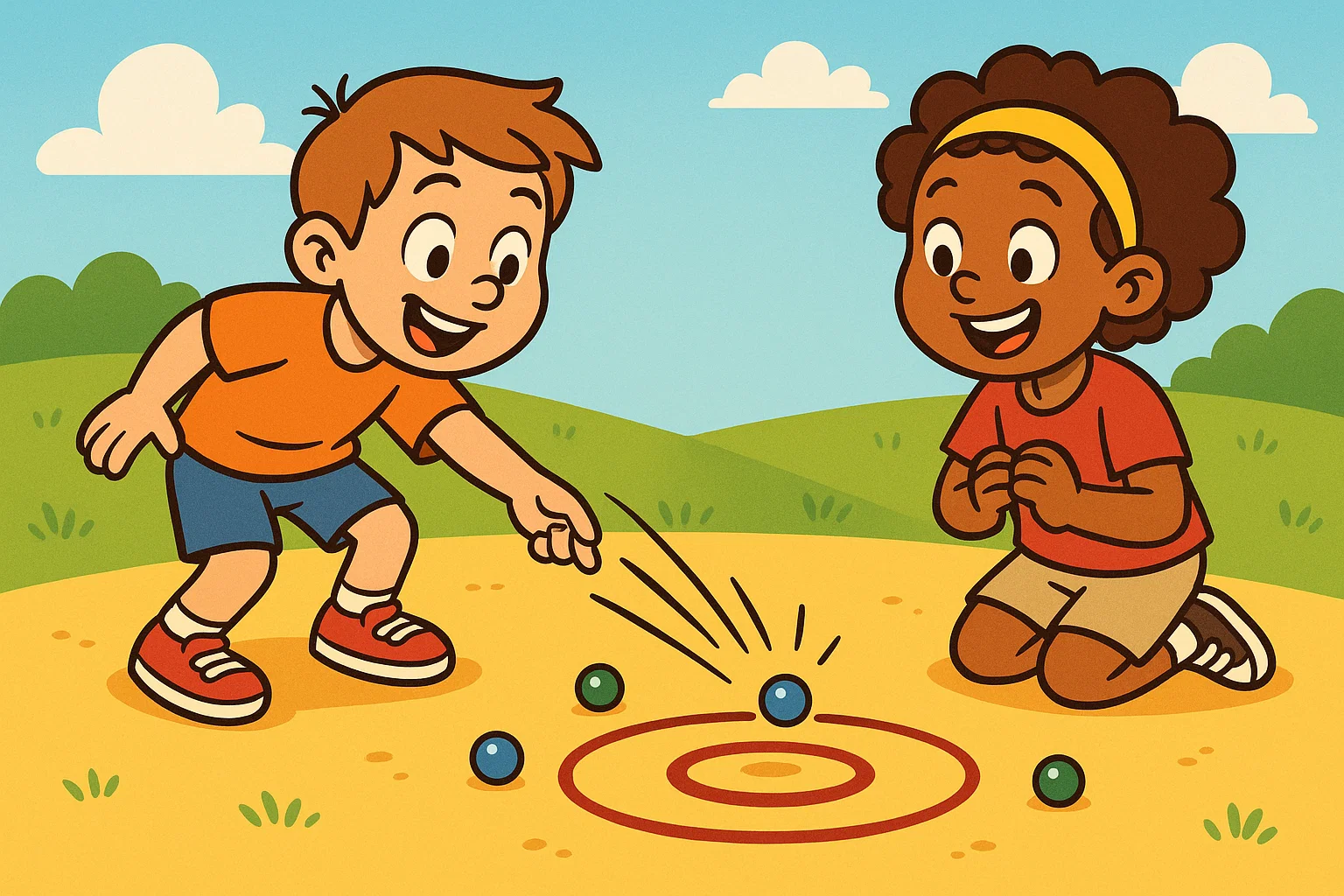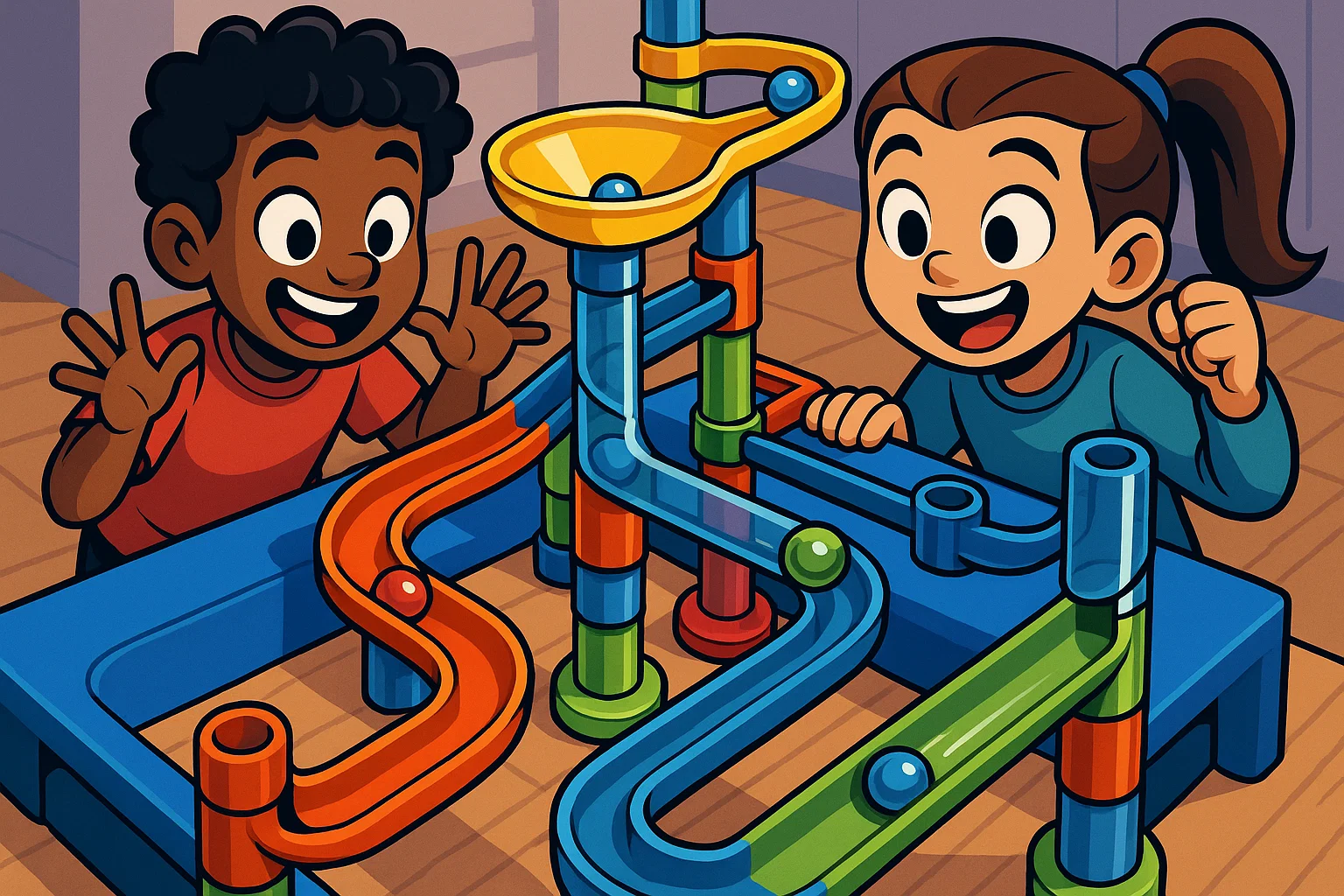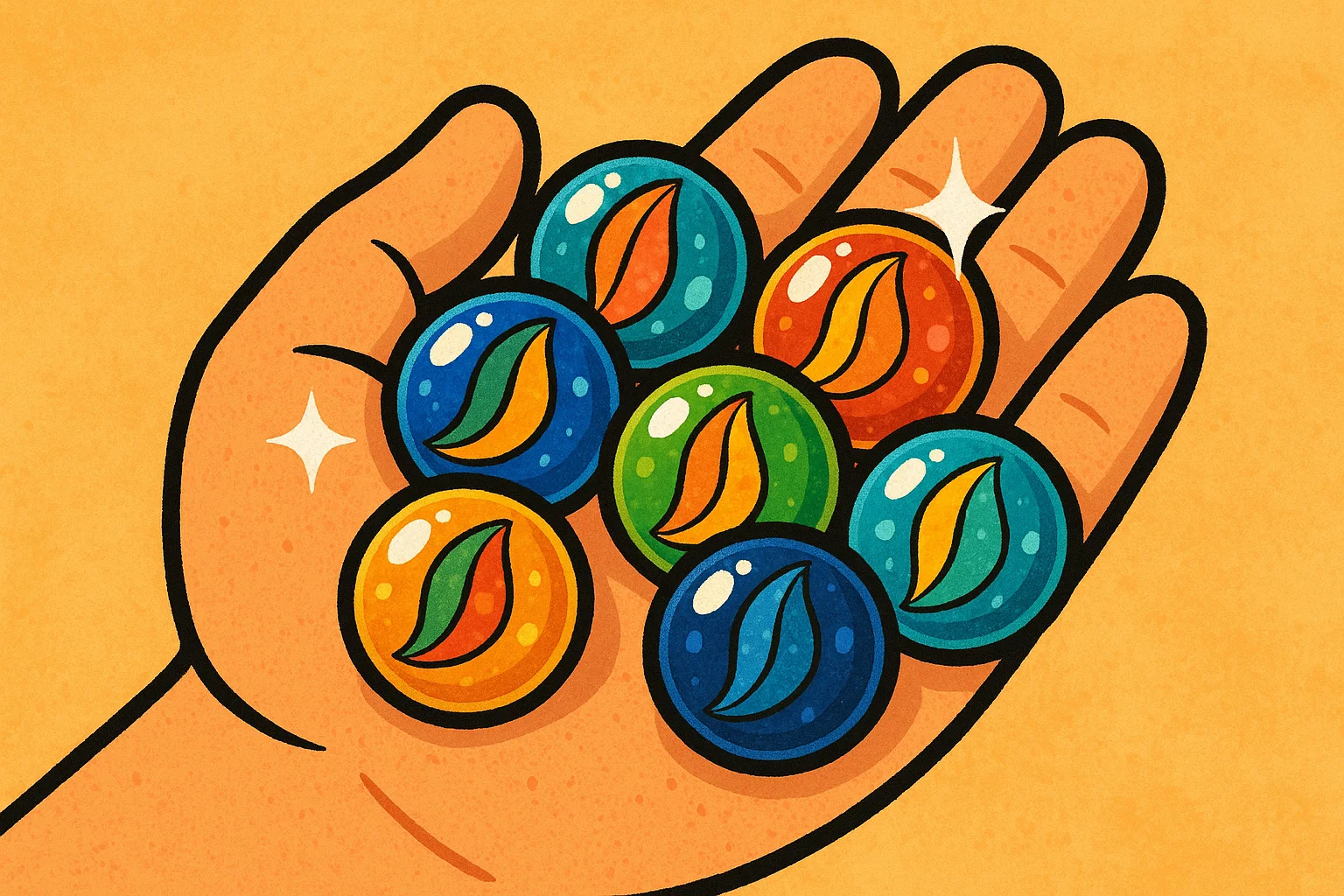Classic Marble Games

Marbles have captivated children and adults for generations, offering simple yet engaging ways to develop skills while having fun. Whether you’re rediscovering the joy of a classic game or introducing your child to their first marble run, these timeless activities provide developmental benefits wrapped in entertainment.
From traditional circle games played on flat surfaces to elaborate DIY runs, the world of marble play extends far beyond what many parents remember from their own childhoods. This comprehensive guide explores both time-honored games and modern innovations that continue to make marbles a valuable addition to any toy collection.
Classic Marble Games and Toss Variations

The beauty of classic marble games lies in their accessibility—most require nothing more than a bag of marbles and a smooth playing surface. These games have survived decades because they’re easy and fun while offering genuine skill development.
Traditional Rules, Play, and Strategy
The game of marbles typically begins when you draw a circle on the ground, traditionally about three feet in diameter. Players place an agreed number of marbles inside this circle, ensuring they’re evenly spaced for fair play. Each participant then takes turns shooting their “shooter” marble (usually a larger glass ball) from outside the circle, attempting to knock other out while keeping their own shooter inside.
The strategic depth emerges from deciding which marble to target. Do you aim for the cluster of marbles to maximize your potential winnings, or do you carefully select a single, easy target? Your shooter technique matters tremendously—experienced players develop a distinctive flicking motion that gives them better accuracy and control.
Basic scoring rules include:
- Each marble knocked out of the circle counts as one point
- If your shooter remains inside the circle after knocking marbles out, you continue your turn
- The player with the most marbles at game’s end wins
- Variations exist where you keep the marbles you knock out, making the competitive game even more exciting
Some families play “keepsies” where the winner keeps all captured marbles, while others prefer “friendlies” where everyone gets their marbles back. This flexibility makes the game suitable for both casual play and serious collecting.
Mini Marble Golf: Rules and Setup
Mini marble golf transforms any space into a creative obstacle course. You’ll need colored marbles, plastic cups or containers serving as “holes,” and household items to create obstacles. The game combines elements of traditional golf with marble play, resulting in a unique challenge.
Set up your course by positioning empty cups at various distances and angles. Between the starting point and each cup, arrange obstacles—books create ramps, empty egg cartons become hazards, and chalk lines drawn on the ground define out-of-bounds areas. Players flick one marble toward each hole, counting their strokes just like real golf.
The setup phase offers as much fun as playing. Children naturally engage their creativity when designing courses, experimenting with different heights, angles, and difficulty levels. This process develops spatial reasoning and problem-solving abilities while they’re simply having fun creating their game.
Marble Toss Variations
Marble toss games provide excellent opportunities for developing hand-eye coordination without requiring elaborate setups. The simplest version involves placing an empty cup several feet away and attempting to toss marbles inside. Increase difficulty by using smaller containers or greater distances.
One popular variation uses an empty egg carton with different point values assigned to each compartment. The smallest cups might be worth 10 points, while easier targets score only 1 or 2 points. This scoring system teaches basic math while players strategize whether to aim for safe, low-value targets or risk missing the higher-scoring options.
Advanced toss variations include:
- Bounce Challenge: Players must bounce their marble once before it lands in the target container
- Multi-Cup Sequence: Set up several cups at varying distances, and players must land marbles in each sequential order
- Timed Rounds: See how many marbles you can successfully toss within 60 seconds
- Team Relay: Groups compete by taking turns, with each successful toss earning their team a point
These simple games require minimal equipment but offer hours of engagement for toddlers and preschoolers through older kids.
Unique Vintage Marble Games
Beyond the classic circle game, vintage traditions offer fascinating alternatives that many modern families have never encountered. “Ringer,” for instance, was standardized in the 1920s and became the official tournament game. It requires a ten-foot ring with specific placement rules, making it more structured than casual backyard play.
“Bridgeboard” represents another historical favorite where players shoot marbles through numbered arches cut into a wooden board. Successfully navigating your marble through the highest-numbered arch wins the round. This game demands precision and encourages players to refine their shooting technique.
“Marble Arch” uses a simple cardboard or wooden structure with multiple archways of different sizes. Smaller openings score more points, creating natural risk-reward decisions. The game develops fine motor skills as children learn to control the speed and direction of their marble with increasing accuracy.
DIY Marble Fun and Creative Projects
Creating your own games and projects transforms passive play into active learning. These DIY activities engage multiple skill sets simultaneously—planning, building, testing, and refining—while producing something genuinely fun to use.
Marble Run Creation Projects
Building a DIY marble run from household materials offers incredible educational value disguised as pure entertainment. You might use cardboard tubes from paper towels, plastic bottles cut lengthwise, and tape to construct increasingly complex pathways. Watch the marbles navigate your creation, then troubleshoot and improve the design.
The engineering principles involved are substantial. Children discover that steeper angles make marbles move faster but may cause them to jump the track. Gentle curves work better than sharp corners. Stable support structures prevent collapses. These aren’t abstract lessons from textbooks—they’re immediate, visible results of design choices.
Materials commonly used in unique marble runs include:
| Material | Best Application | Developmental Benefit |
| Cardboard tubes | Straight runs and tunnels | Understanding gravity and momentum |
| Pool noodles (cut lengthwise) | Curved pathways | Spatial reasoning and planning |
| Plastic bottles | Funnels and collection points | Cause-and-effect recognition |
| Wooden blocks | Support structures | Stability concepts and engineering basics |
| Tape and glue | Connections | Fine motor practice and patience |
Start with simple, short runs that reliably work, then gradually add complexity. The sense of accomplishment when marbles successfully complete an elaborate course is powerful and encourages further experimentation.
“Booby Trap” Game Setup
The booby trap concept turns marble play into a delicate test of steady hands and careful strategy. Set up a course where players must navigate their marble through a path filled with obstacles without triggering “traps” that end their turn.
Create your booby trap course on a flat surface using household items. Position translucent marbles or small bells as sensors that, if touched, mean the player loses their turn. Draw a chalk pathway that the marble must follow without veering off course. Add challenge by including narrow passages between stacked books or under low archways.
This game naturally teaches impulse control and careful motor planning. Children must move deliberately rather than rushing, learning that speed isn’t always advantageous. The game also works well for mixed-age groups since you can adjust difficulty by widening or narrowing the safe path.
“Guess How Many” Marble Challenges
Fill clear plastic cups or containers with varying quantities of marbles and challenge players to estimate the number inside. This deceptively simple activity builds mathematical reasoning and visual estimation skills. After all players record their guesses, count the marbles together to find the winner.
Enhance the educational value by discussing estimation strategies. Encourage children to count a small section, then multiply to estimate the total. This introduces practical multiplication concepts in a natural context. Using different colored marbles within the same container allows you to ask multi-part questions: “How many red marbles? How many blue? What’s the total?”
The game works particularly well at parties or gatherings where you need an activity that accommodates children of different ages. Younger children practice basic counting, while older kids develop more sophisticated estimation techniques.
Marble Art and Science Projects
Marbles become art supplies when you roll them through paint on paper placed inside a shallow box. The resulting patterns are unpredictable and beautiful, demonstrating principles of motion and trajectory while creating take-home masterpieces. Each marble creates unique lines based on its weight, the paint consistency, and the rolling surface angle.
Science experiments with marbles explore physics concepts through hands-on experience. Investigate friction by rolling marbles across different surfaces—smooth wood, rough carpet, or textured tile. Measure how far each marble travels and discuss why results vary. Explore momentum by colliding marbles of different sizes and observing what happens to their speed and direction.
Another engaging project involves building a maze inside a shoebox lid. Glue cardboard strips or straws to create pathways and dead ends, then tilt the box to navigate your marble to the finish. This combines the planning phase of construction with the immediate feedback of testing your design.
Best Interactive Marble Games to Buy

While DIY projects offer unique benefits, manufactured games provide sophisticated mechanics and reliability that’s difficult to achieve with household materials. The market offers impressive options across different price points and complexity levels.
Top-Rated Interactive Marble Run Sets
Commercial run sets come with precisely engineered pieces that connect reliably, allowing you to build elaborate structures without the frustration of homemade versions that might collapse. Leading brands offer modular systems where each purchase expands your collection, letting you create increasingly ambitious designs.
Quality marble run sets typically include various track types—straight runs, curves, spirals, and drops—along with action features like wheels, bells, or see-saws that marbles activate. These features transform a simple gravity-powered descent into an engaging show that children watch repeatedly.
Key features to consider when selecting a marble run:
- Compatibility: Can you combine pieces from different sets or expansion packs?
- Stability: Do assembled structures stand reliably without constant supervision?
- Piece variety: Does the set include enough different elements to maintain interest?
- Marble size: Ensure included marbles are age-appropriate (larger marbles for younger children to prevent choking hazards)
- Educational value: Look for sets that include building instructions of increasing complexity
Many parents report that a high-quality run becomes a toy their children return to for years, making it a worthwhile investment in their collection of marbles and interactive games.
Strategy Marble Board Games
Modern board games have reimagined traditional play into strategic challenges. “Abalone,” for instance, requires players to push their opponent’s marbles off the board using careful positioning and numerical superiority. The game may seem simple initially, but deeper strategy emerges after a few plays.
“Chinese Checkers” remains popular because it scales from two to six players while maintaining balanced gameplay. The marble-hopping mechanism is intuitive enough for young children but offers strategic depth that adults appreciate. Games like these demonstrate how marbles facilitate both competitive gameplay and quality family time.
Other strategy marble board games incorporate elements of chance through dice or spinners, creating experiences where planning meets adaptability. These games teach children that even the best strategy sometimes requires adjustment when circumstances change—a valuable life lesson delivered through play.
Unique Action and Skill Marble Games
Action-oriented games emphasize physical skill and timing rather than strategic planning. “Ker-Plunk” challenges players to carefully remove sticks from a tube without letting the marbles resting on them fall through. Each turn combines fine motor control with risk assessment as you decide which stick seems safest to remove.
Marble racing games create excitement through competition without complex rules. Multiple marbles race down parallel tracks, and the first to reach the bottom wins. Simple premise, but watching marbles accelerate and occasionally collide creates genuine suspense. These games work exceptionally well for groups since multiple people can race simultaneously.
Balance-based games require players to tilt platforms or navigate marbles through three-dimensional mazes without dropping them into holes. These challenges develop spatial awareness and hand-eye coordination while providing immediate, visible feedback about your control and precision.
Innovative Marble Maze Challenges
Maze games present increasingly complex puzzles where you tilt a platform to guide your marble through a path toward a goal while avoiding holes and dead ends. The combination of planning the route and executing the movements makes these games particularly engaging.
Advanced mazes include multiple levels, requiring you to navigate marbles through specific sequences. Successfully completing one section grants access to the next, creating a sense of progression. This structure keeps players motivated to improve their skills and attempt more challenging courses.
Wooden mazes often feature beautiful craftsmanship that makes them attractive display pieces when not in use. The tactile quality of wood combined with the visual appeal of glass marbles creates an object that adults appreciate as much as children enjoy playing with it.
Marble Play, Glass Marbles, and Development

Understanding the developmental benefits of marble games helps parents recognize that this simple toy delivers significant educational value. From physical skill development to cognitive growth, marbles offer surprisingly comprehensive learning opportunities.
Glass Marbles: Types and Care
Glass marbles come in remarkable variety, from solid-colored “clearies” to elaborate designs with internal swirls, figures, or patterns. Collectors prize certain vintage marbles, but for everyday play, standard glass marbles offer durability and attractive appearance at accessible prices.
Common marble types include:
| Type | Description | Best Use |
| Cat’s Eye | Clear glass with internal colored swirls | General play and collecting |
| Clearies | Transparent, single-color marbles | Games requiring visibility |
| Swirls | Opaque base with colorful bands | Aesthetic appeal in runs and displays |
| Aggies | Made from agate stone (traditional) | Serious play and collecting |
| Shooters | Larger marbles (often 3/4″ to 1″) | Player’s marble in traditional games |
Proper care extends marble life and maintains their appearance. Store them in a fabric bag rather than plastic to prevent scratching. Clean with warm water and mild soap, then dry thoroughly to maintain their luster. Avoid storing in direct sunlight, which may fade certain dye colors over time.
Teaching children to care for their marble collection instills responsibility and respect for their possessions. Sorting marbles by color, size, or pattern becomes its own activity that develops categorization skills.
Improving Motor and Fine Motor Skills
Nearly every marble activity contributes to developing fine motor skills. The flicking motion required in traditional games strengthens finger muscles and improves finger independence—the ability to move individual fingers without engaging others unnecessarily.
Threading marbles onto string or placing them carefully into narrow openings develops the pincer grasp essential for writing. These activities prepare young hands for academic tasks while feeling like pure play. The progression from clumsy early attempts to precise, controlled movements happens naturally through repeated, enjoyable practice.
Hand-eye coordination develops as children track moving marbles and time their actions accordingly. Catching a rolling marble or shooting to hit a moving target requires visual processing, decision-making, and motor execution to work in concert. Research published on frontiers suggests that activities promoting hand-eye coordination may support broader cognitive development, though more study is needed to establish definitive causal relationships.
Strategy and Logic Growth Through Marbles
Strategy games with marbles teach planning ahead and considering multiple possible outcomes. Before shooting in a traditional circle game, experienced players visualize where their marble will end up and whether it positions them well for subsequent shots. This mental simulation exercise develops abstract thinking.
Marble runs require cause-and-effect reasoning—if I place the track here, the marble will roll there, then continue this direction. Children testing their designs receive immediate feedback, creating strong learning connections between their choices and resulting outcomes. This concrete experience with physical principles builds intuitive understanding that supports later abstract learning in science and mathematics.
Competitive games introduce concepts like turn-taking, rule-following, and gracious winning or losing. These social-emotional skills matter as much as cognitive development. Playing traditional games with peers naturally creates opportunities to practice negotiation when disputes arise and empathy when opponents experience disappointment.
Historical Evolution of Marbles
Marbles have entertained humans for millennia—archaeologists have found clay marbles in ancient Egyptian tombs and stone marbles from Rome. Understanding this history helps children recognize they’re participating in something truly timeless that connects them to countless previous generations.
The golden age of American marble manufacturing occurred between 1890 and 1950 when companies produced millions of handcrafted glass marbles annually. Many vintage marbles from this era remain in circulation, occasionally appearing in inherited collections. Examining the craftsmanship in antique marbles reveals how much skill went into creating what children considered disposable toys.
Modern marble manufacturing has evolved to include materials beyond glass, though traditional glass marbles remain popular. Steel marbles roll differently and make distinctive sounds in runs. Plastic marbles offer safety for very young children. Each material creates different play experiences, and many serious marble enthusiasts maintain separate collections for different purposes.
Online Marble Games
Digital marble games offer different experiences than physical play, with unique advantages and limitations. Understanding both helps parents make informed decisions about screen time and how digital games fit into their children’s broader play experiences.
Available Platform Options
Browser-based marble games require no downloads or installations, making them immediately accessible on computers, tablets, or smartphones. Many websites offer marble race simulations, maze challenges, and physics-based puzzles featuring mechanics. These games often provide quick entertainment during short breaks.
Mobile apps dedicated to marble gameplay range from simple physics puzzles to elaborate run designers where you construct digital courses then release marbles to test your creation. Some apps offer multiplayer functionality, letting players compete with friends remotely. The touchscreen interface often feels intuitive, especially for children already comfortable with digital devices.
Gaming consoles and PCs host more sophisticated marble titles, some featuring stunning graphics and complex level design. These games may incorporate marble mechanics into larger adventure or puzzle frameworks, creating substantial experiences that extend beyond simple marble rolling.
Advantages of Physical Versus Online Games
Physical marble games provide tactile feedback that digital versions cannot replicate. Feeling the weight of a glass marble, hearing it click against others, or watching it roll across an actual surface engages sensory systems more fully than screen-based play. This multi-sensory engagement appears to support deeper learning, according to child development research, though individual experiences vary.
The social dimension differs significantly between physical and online marble play. Gathering around a physical game board or collaborative building project creates shared focus and face-to-face interaction. While online multiplayer games enable connection across distances, they don’t fully replace the communication skills developed through in-person play.
Comparative benefits:
| Aspect | Physical Marbles | Online Games |
| Tactile learning | Fully engages touch and manipulation | Visual and auditory only |
| Social interaction | Face-to-face communication | Distance connection possible |
| Fine motor development | Direct skill building | Limited transfer to physical skills |
| Creative freedom | Materials-dependent but highly flexible | Often constrained by program parameters |
| Cleanup and storage | Requires space and organization | No physical footprint |
| Cost over time | One-time purchase for lasting value | Often free but may include ads or purchases |
Neither format surpasses the other universally—instead, they offer complementary benefits. Physical marbles excel at developing motor skills and providing sensory-rich experiences, while digital versions offer convenience, variety, and accessibility.
The Digital Marble Gaming Experience
Well-designed digital marble games create engaging puzzle-solving experiences that exercise spatial reasoning and planning skills. Games that require designing marble courses, then testing them virtually, teach similar principles to physical runs—if somewhat less concretely.
Physics simulation quality varies dramatically between digital games. Premium titles accurately model momentum, friction, and collision, creating realistic behavior that helps players build intuitive understanding of these forces. Lower-quality games may have inconsistent physics that actually confuses these concepts.
Some families successfully integrate both physical and digital marble play, using online games during travel or wait times while prioritizing physical marbles at home. This balanced approach harnesses the benefits of each format without over-relying on either.
General Questions Marble Games
What is a great game to play for beginners?
A great game to play when starting out is “Ringer.” It’s a very fun game because the rules are simple, and it’s fun to play right away. Learning different ways to play helps quickly develop the basic skills needed for more challenging contests.
What are the best tactics to get the marble of your opponent?
To successfully get the marble of your opponent, master the basic “knuckle down” shot. Learn to control the force of the strike so that your marble and hit are precise. In some games, it’s permissible to bounce your marble off an obstacle, which can be an excellent tactical maneuver.
What can we do if we only have two marbles?
Even with just two marbles, you can still play with marbles using a simple game like “Keep-Away” or “Line Tag” to practice aiming. Once you acquire another marble, you can transition to more complex rules, such as those involving elimination from a circle.
What is the best marble to choose and how can we enjoy games the most?
The best marble is one that feels comfortable and balanced in your hand, often a medium-sized glass shooter. To truly enjoy games, don’t be afraid to experiment with new rules. Marble games are fun but also excellent for developing strategic thinking and fine motor skills.
How much ton of fun can we have with fun marble games?
Fun marble games guarantee a ton of fun! You can watch the action of the marbles and see how your aiming and trajectory improve. You can even get even more fun by creating your own unique rules and challenges.
